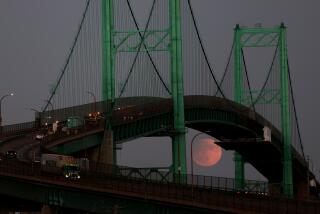Harvest, Hunter, Hunger, Snow : Names for Full Moon: Insight Into Past
WASHINGTON — Nearly half a year ago, the bright Harvest and Hunter’s moons lighted the nighttime sky. But in the chill of the year comes the full moon known by the names Wolf, Snow and Hunger.
This dire moon came full on Feb. 2, adding its spell to a day also known as Candlemas and celebrated in the United States as Groundhog Day.
Snow lays across much of the land, easily justifying that name for the moon, given by the Chippewas and other northern tribes.
Wolf and Hunger are also used as its names, denoting the time of year when food is most scarce for everyone, sometimes driving hungry wolves from the forests in search of sustenance.
Little Warmth
The full moon of February sheds light with “no more warmth than the frost cloud of a man’s breath,” observed the late Hal Borland in his book “Twelve Moons of the Year.”
“It burned the darkness with neither heat nor smoke, strewing the snow with charred skeletons of the naked trees. No wonder the Indians knew the February full moon as the Hunger Moon,” Borland wrote.
The Harvest Moon is probably the best-known name for a full moon in this country--remembered as a time of high school hayrides and always reported by television weather announcers.
That moon, usually in September, is the full moon closest to the autumnal equinox and provides the longest period of moonlight in the Northern Hemisphere.
Indian Lore
Hunter’s Moon comes in October, offering light for the hunter much as Harvest did for the late-toiling farmer.
The lore of Indians and early settlers provided names for all the full moons of the year, most less well-known but all offering insight into the lives and worries of people in past centuries.
This February moon, for example, tells of their concern about the snow, their fear of wolves and perhaps an even greater fear of starvation, with cached food running low, game scarce and little in the way of forage left in the forests.
Besides the three most common names, the February moon also was called Trapper’s Moon by other Indians. Still others called it the Crust of Snow Moon, to differentiate the changing snow conditions from month to month.
Year of Names
Here is a rundown of the names given the full moons of the year. Some names are used in different areas for differing months.
These have been collected from a variety of sources, including the Astronomical Calendars prepared by Guy Ottwell at Furman University, articles by weather historian David M. Ludlum in Country Journal magazine and information provided by Gail S. Cleere of the U.S. Naval Observatory.
- January: Old Moon, Moon After Yule, Wolf Moon, Winter Moon, Deep Snow Moon.
- February: Snow Moon, Hunger Moon, Wolf Moon, Trapper’s Moon, Crust of Snow Moon.
- March: Sap Moon, Crow Moon, Lenten Moon, Fish Moon, Worm Moon, Snowshoe Breaking Moon.
- April: Grass Moon, Egg Moon, Sprouting Grass Moon, Pink Moon, Planter’s Moon, Maple Sugar Moon.
- May: Planting Moon, Milk Moon, Mother’s Moon, Flower Moon, Budding Plant Moon.
- June: Rose Moon, Flower Moon, Strawberry Moon, Stockman’s Moon. Ludlum also has suggested that, considering the popularity of June weddings, this could be termed the “Honey Moon.”
- July: Thunder Moon, Hay Moon, Buck Moon, Summer Moon, Midsummer Moon.
- August: Green Corn Moon, Grain Moon, Sturgeon Moon, Harvest Moon.
- September: Harvest Moon, Fruit Moon, Fall Moon, Wild Rice Moon.
- October: Hunter’s Moon, Dying Grass Moon, Harvest Moon, Falling Leaves Moon.
- November: Frosty Moon, Beaver Moon, Hunter’s Moon, Freezing Moon.
- December: Long Night Moon, Moon Before Yule, Cold Moon, Christmas Moon, Descending Cold Moon.
More to Read
Sign up for The Wild
We’ll help you find the best places to hike, bike and run, as well as the perfect silent spots for meditation and yoga.
You may occasionally receive promotional content from the Los Angeles Times.






